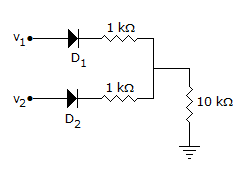Electronics and Communication Engineering - Analog Electronics - Discussion
Discussion Forum : Analog Electronics - Section 1 (Q.No. 7)
7.
In figure v1 = 8 V and v2 = 4 V. Which diode will conduct?


Answer: Option
Explanation:
D1 will conduct and the output voltage will be about 7 V. Therefore D2 will be reverse biased and will not conduct.
Discussion:
32 comments Page 2 of 4.
Neha said:
8 years ago
@Nikkie
You will get V = 40/7 which is 5.7.
Hence, d1 will conduct and d2 will be reverse bias and won't conduct.
But from above statement how can tell that d1 will conduct?
You will get V = 40/7 which is 5.7.
Hence, d1 will conduct and d2 will be reverse bias and won't conduct.
But from above statement how can tell that d1 will conduct?
Henna said:
8 years ago
How V is V/10?
Priya said:
9 years ago
Thanks for the explanation @Nikkie.
Nikkie said:
9 years ago
First take: I(1) + I(2) = I.
where I(1) = (V-8)/1k ohm.
similarly I(2) = (V-4)/1k ohm.
And I = V/10k ohm.
Next solve for 'V' ( USING KCL AT NODE V).
You will get V = 40/7 which is 5.7 something.
Hence, d1 will conduct and d2 will be reverse bias and won't conduct.
where I(1) = (V-8)/1k ohm.
similarly I(2) = (V-4)/1k ohm.
And I = V/10k ohm.
Next solve for 'V' ( USING KCL AT NODE V).
You will get V = 40/7 which is 5.7 something.
Hence, d1 will conduct and d2 will be reverse bias and won't conduct.
Surya said:
9 years ago
Both the diodes are conducting because p>n
p:positive terminal.
n:negative terminal.
This concept from pulse and digital circuits.
p:positive terminal.
n:negative terminal.
This concept from pulse and digital circuits.
Kiran said:
9 years ago
@All.
First check current through both the diodes and ACC to the direction of current you can identify which diode is working.
First check current through both the diodes and ACC to the direction of current you can identify which diode is working.
Saurabh said:
1 decade ago
How ! both diode are forward than only d1 way ?
Ramkamal said:
9 years ago
V1and V2 is not mentioned they are AC/DC. Secondly practically diode voltage drop 1v then both are forward biased.
Sharma said:
9 years ago
Could anyone explain clearly how diode (D1) alone conducts and not the other?
Raushan said:
9 years ago
Assume both diodes are in forward bias, then after doing node analysis, the node at the intersection of 3 resistors, has the potential of 5 V (assuming cut off voltage 0.7V), which contradicts, so only one diode is in forward bias.
Post your comments here:
Quick links
Quantitative Aptitude
Verbal (English)
Reasoning
Programming
Interview
Placement Papers